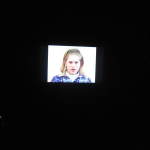"I remember loving sound before I ever took a music lesson. And so we make our lives by what we love."
- John Cage, Lecture on Nothing, 1949
Our relation to music is deep and, one could say, integral to what it means to be human. Since the beginning of time man has made music. From the banging of rocks to Pro-tools we have an intimate relationship to music. Whether as a fan or a maker, music knows no boundaries or borders. And as long as there have been musicians, there have been artists influenced by music. I imagine that as prehistoric man was painting on the walls of Lascaux there were others in the cave, banging out a groove on some rocks and sticks. It is this relationship that is explored in the current Contemporary Outlook exhibition at the Museum of Fine Arts, Boston titled Seeing Songs. The exhibition is premised on the notion that artists, in responding to music, are rendering something inherently intangible and experiential into a physical form. This is a fairly simple concept and one that I think does ring true. However, since one's relationship to music is highly personal and subjective can the idea imparted in the artwork translate?
The majority of the work in the show is pulled from the Museum's collection and points to its strengths. The paintings by Arthur Dove and Stuart Davis, which I initially disliked at the show's opening, actually made sense upon a revisit. While I don't think either of them is particularly strong (hence my initial reaction) I came to realize that they do point to continuity in artist's relationships with music especially in the twentieth century. They reflect the way that artists found kinship between themselves and the jazz musicians of the time. Both groups were operating on the margins of society and both seeking some way in which to translate an increasingly complicated world with their art. They ground the exhibition conceptually but serve merely as appetizers before the main course.
The first piece to really jump out at me was Gillian Wearing's "Slight Reprise" from 1994-95. The video piece consists of several young men playing air guitar in their bedrooms. The songs range from Guns and Roses to the Allman Brothers and the performers reflect that cultural difference. The videos are brutally honest portrayals of the performers love of the music. Playing air guitar is their one means of physically engaging with the musicians they love. It is interesting to watch this video, now fifteen years old, in the age of Rock Band and Guitar Hero. Today technology enables the most musically challenged person to physically become the band or musician. These games bridge the gap between performer and fan. There is something really powerful occurring when these men "perform" the songs with an imaginary guitar. Their hands and bodies physically embody the imaginary. There is no instrument in their hands and yet their performances are so heartfelt and earnest that one can believe that they are playing along with the song. It is, once again, the capturing of the moment where one's love of music is manifested by the body. It is worth it to sit and watch the full DVD as each performer is similar in body movement yet interacts and performs the song in very different ways. Good stuff.
Two other stunning pieces were by the artist Idris Khan: "Wagner – Parsifal" and "Hearing Voices: Schumann's Violin Concerto." Khan's photographs of superimposed scores layered upon each other hang on the walls like tapestries. The curl and sweep of the notes become a pattern across the paper looking very much like ancient script with the white of the background paper glowing behind the grey of the text.
But the main focus of the exhibition is South African artist Candice Breitz's "Queen (A Portrait of Madonna)," which is, honestly, quite hard to miss. There are thirty monitors (six across and five high) screening thirty different people singing along to Madonna's "Immaculate Collection" album. Much like Wearing's video, Breitz has captured ordinary people caught up in their love of a musical artist. Each of the performers has a different take on the songs – some throw themselves into the music with complete abandon and disregard for coherence while others attempt to emulate Madonna by re-enacting poses from the videos for the songs. What is fascinating is that each of them has a distinctive relationship not only to the music of Madonna but also to the persona that she presents. A couple of them have opted to wear attire similar to hers (there is a cowboy hat with an "M" on it amongst other accoutrements) and others look like they simply wandered off the street. Breitz videotaped hundreds of performers so the selection of singers is part of the construction of the piece along with the placement of each on the wall. My favorite juxtaposition is the heavily made-up man with a giant earring and eighties-style upswept hair (who occasionally stops to reapply his eye makeup) against the young man who could very well be a member of the Backstreet Boys. It is a fascinating piece to watch – and offers up an interesting opportunity to watch the crowd of museum attendees. The piece is lively and pulls the audience in with its sheer joy and silliness. Breitz is investigating an interesting cultural moment but doesn't get bogged down in seriousness.
Finally, you should make sure to see one of the other strong pieces in the show that is hidden behind the wall of monitors. Here, in a little viewing room is Rineke Dijkstra's video "Annemiek" from 1997. Dijkstra is more known for her large photographic portraits of young people but has also made several videos of people interacting with music. Here she has an intimate little video that is (somewhat) heartbreaking. It is simply a portrait of a little girl singing along to a Backstreet Boys song. The girl struggles to hold in her emotions as she sings lyrics that are pretty suggestive (the song is "I Wanna Be With You"). At times she looks incredibly awkward and embarrassed to be there and at others she looks like she's going to break down and cry. It is really quite remarkable.
Overall the show definitely holds up to the concept. There is strong work that really investigates and touches upon our desire to interact and embody our music. There are a couple of things that seem forced (you got your Herb Ritts portraits) but it is, overall, an interesting show. Thanks to the increasing ubiquity of mp3 players music is increasingly a part of our day-to-day existence. These devises enable us to construct a soundtrack to every movement we make and we should stop and ask ourselves what this means. How is this changing our relationship to the music and the artist? Interesting questions.
- Candice Breitz, Queen (A Portrait of Madonna), DVD, 2005.
- Candice Breitz, Queen (A Portrait of Madonna), DVD, 2005. Detail.
- Rineke Dijkstra, Annamiek, DVD, 1997.
"Contemporary Outlook: Seeing Songs" is on view until February 21st, 2010 at The Museum of Fine Arts, Boston.
All images are courtesy of the artist and Museum of Fine Arts, Boston.







